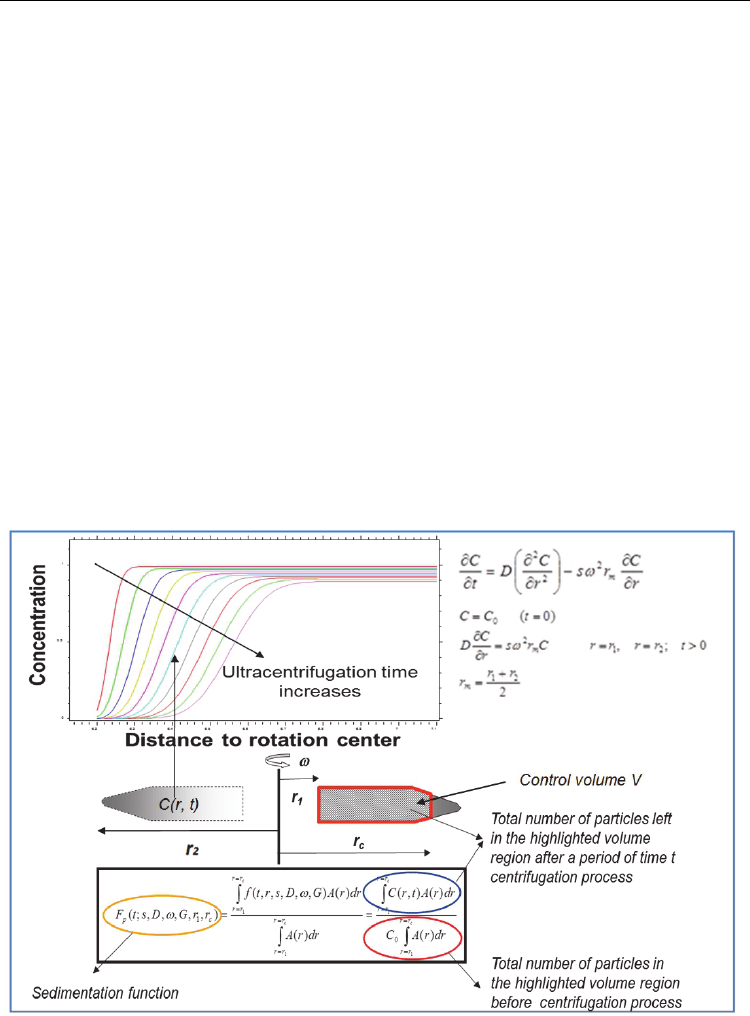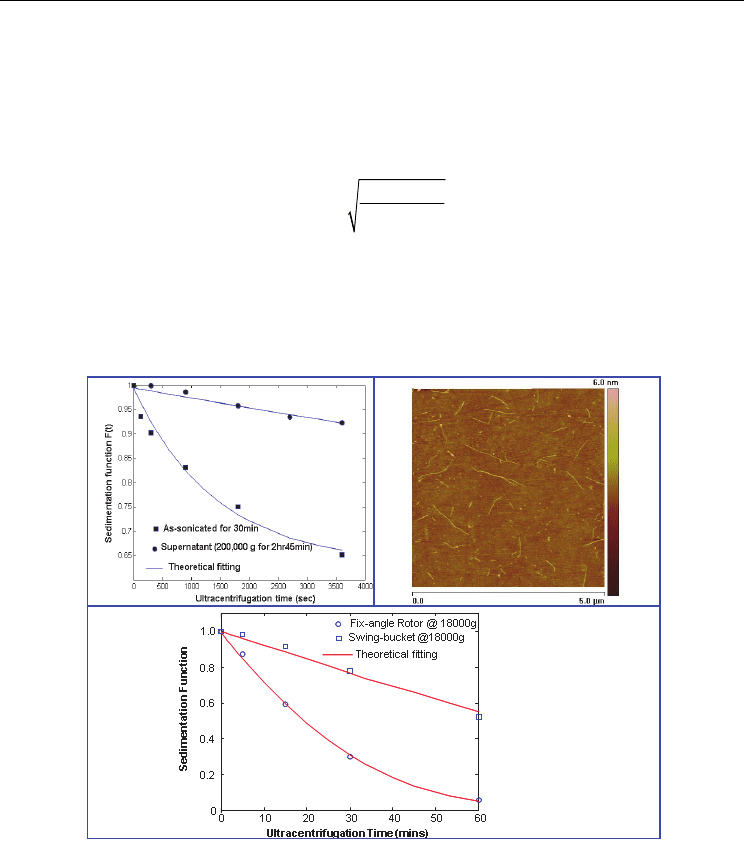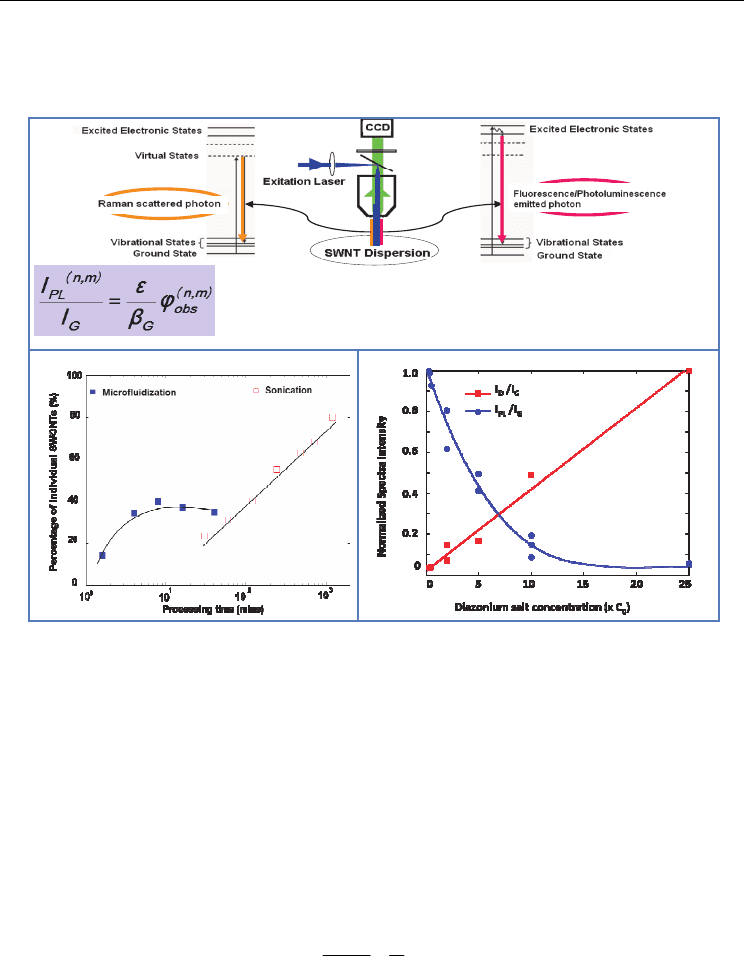Yellampalli S. (ed.) Carbon Nanotubes - Synthesis, Characterization, Applications
Подождите немного. Документ загружается.


In-Situ Structural Characterization of SWCNTs in Dispersion
247
where n is the number density of the particles;
is the difference in scattering length
density (scattering length per unit volume of the dispersion particle) between the particles
and the dispersing medium;
v is the volume of the particle; P(q) is the particle form factor
due to the intra-particle contribution to the scattering and characterizes the particle size and
shape; and
S(q) is the structure factor to reflect the inter-particle contribution to the
scattering, which characterizes the relative positions of different particles and contains the
interaction information between the particles. Owing to the difficulties of separating the
inter- and intra-particle contributions to the dispersion structure, the scattering experiments
are usually carried out for dilute dispersion system to minimize the inter-particle
contribution. In this case, the structure factor
S(q) = 1. Without introducing the complication
of the inter-particle contribution, the size and shape of the particles in a dilute dispersion
can be determined by fitting the scattering intensity with Eq. (6) by applying appropriate
form factor
P(q). Pedersen (Pedersen, 1997) summarized 27 different form factors, a few of
which relevant to the structural characterization of SWCNT dispersions are given below:
1.
Form factor for cylinder of length L and radius R
2
/2
1
1
0
sin ( cos ) /2
2( sin)
() sin
sin ( cos ) /2
qL
JqR
Pq d
qR qL
(7)
where J
1
(x) is the Bessel function of the first kind of order one.
2.
Form factor for flexible polymer chain
22 22
2
2
22
2exp( ) 1
()
gg
g
qR qR
Pq
qR
(8)
where R
g
2
is the mean squared radius of gyration of a Gaussian chain and equals to (L
c
l
k
)/6.
L
c
is the contour length and l
k
is the Kuhn step length of the polymer chain.
3.
Form factor for cylinder of length L and radius R with attached N
c
Gaussian chains of
contour length L
c
22 2
31212
2
1
() () () ( 1) () 2 ()
cc c c c c c
cc
Pq Pq N Pq N N Sq N S q
N
(9a)
2
22
/2
2
10
22
0
1exp( )
( ) 2 ( sin )cos ( cos ) /2 sin
g
g
qR
Sq JqR qL d
qR
(9b)
22
/2
1
2 0
22
0
1exp( )
sin ( cos )/2
2( sin)
() 2 ( sin )
sin ( cos ) /2
cos ( cos )/2 sin
g
g
qR
qL
JqR
Sq JqR
qR qL
qR
qL d
(9c)
where J
0
(x) is the Bessel function of the first kind of order zero;
and
c
is respectively the
total excess scattering length of the cylinder and the polymer chains.
Dror (Dror et al., 2005), Yurekli et al. (Yurekli et al., 2004) and Granite et al. (Granite et al.,
2010) respectively investigated the structures of styrene-sodium mealeate copolymer and

Carbon Nanotubes - Synthesis, Characterization, Applications
248
gum arabic wrapped, SDS–stabilized, and pluronic copolymer dispersed SWCNT
dispersions by SANS technique. All these studies indicated that the dispersing agents, either
the ionic surfactant SDS or the copolymers being used, adsorbed on the SWCNTs to form a
core-shell structure, in which the core is formed by thin SWCNT bundles and the shell is
attributed to the physical adsorption of the dispersing agents. With the refined cylindrical
core-shell form factors, the diameter of the core and the thickness of the shell have been
determined by fitting the experimentally determined SANS scattering intensity. It is
particularly interesting to note that, for the SDS-stabilized SWCNT dispersions, the SANS
experiments indicated that, within the shell, the SDS surfactant molecules do not form any
ordered micelle structures but are randomly distributed (Yurekli et al., 2004). One recent
molecular dynamic simulation study on the SDS aggregation on SWCNTs (Tummala &
Striolo, 2009) supports such a viewpoint. However, another MD simulation study (Xu et al.,
2010) reveals a much delicate situation for the SDS structure formation on SWCNTs.
Depending upon the diameter of SWCNT as well as the coverage density, the SDS
molecules can organize into cylinder-like monolayer structure, hemicylindrical aggregates,
and randomly organized structures on the surface of a SWCNT. It is expected that the
combined simulation and scattering experiments could ultimately help to have a better
understanding of this interesting phenomena.
In addition to the above described form-factor modeling approach, another commonly used
method for understanding, analyzing and interpreting the small-angle scattering data is by a
much simpler and physically appealing scaling approach (Oh & Sorensen, 1999; Sorensen,
2001). The scaling approach is based on a comparison of the inherent length scale of the
scattering, 1/q, and the length scales in the system of scatterers to qualitatively understand
the behaviors of the differential scattering cross section in relation to the structures of the
scattering system. Two limiting situations can be used for illustrating the principle of the
scaling approach. When the n scatterers are within a 1/q distance from each other, the phase
of the n scattered waves will be in phase and
1
jk
qr r
. In this case, the double sum in
Eq. (5a) equals to n
2
. On the other hand, when the n scatterers are separated from each other
by a distance greater than 1/q, the phase of the n scattered waves will be random and
1
jk
qr r
. In such a case, the double sum in Eq. (5a) equals to n. With these results and
bear in mind that, for a finite-sized scattering system with uniformly distributed scatterers,
the non-zero scattering contribution at a scattering angle other than zero is due to the
scatterer density fluctuation on the surface, one can derive a power-law relationship for the
scattering intensity of a fractal aggregate with respect to the inherent length scale of 1/q (Xu
et al., 2010). It is stated as:
2
() 1/
D
D
gg
d
InqR fora qR
d
(10)
where D is the fractal dimension of an aggregate system. For a homogeneous 1D rod, D = 1;
2D disk, D = 2; and 3D sphere, D = 3. Eq. (10) applies to a fractal aggregate system defined
by two length scales: a is the size of the scatterer and R
g
is the radius gyration of the
aggregate. The scaling approach makes the physical significance of the inherent length scale
1/q more transparent and easier to comprehend.
With the help of Eq. (10), the fractal structures of SWCNTs in the dispersion have been
investigated by SAXS (Schaefer et al., 2003a; 2003b), SANS (Zhou et al., 2004; Wang et al.,

In-Situ Structural Characterization of SWCNTs in Dispersion
249
2005; Bauer et al., 2006; Hough et al., 2006; Urbina et al., 2008) and SLS (Chen et al., 2004).
Depending upon the sample preparation conditions, both the rigid-rod structure of
SWCNTs (with D = 1) and the entangled SWCNT fractal networks (2 < D < 3) have been
observed. It is noted that, among the different scattering techniques being used for
characterizing the SWCNT structures in different types of dispersions, the SANS was more
popular than the others. This is partially attributed to the relatively high scattering contrast
(
) of SWCNTs when interact with neutron as compared to X-rays. In addition, the strong
optical absorption of SWCNTs in the visible light region could potentially complicate the
SLS experiments and make the data interpretation and analysis more difficult. The
experimental difficulties related to the SLS technique for the structural characterization of
SWCNT dispersions has not been given sufficient attention.
The scattering experiments introduced above rely on measuring the time-averaged
scattering intensity as a function of the scattering vector for characterizing the dispersion
structures. In addition to this approach, another type of scattering experiments, e.g.,
dynamic light scattering (DLS) or quasi-elastic light scattering (Chu, 1991; Berne & Pecora,
2000; Teraoka, 2002), is also a valuable technique for in-situ characterizing the dispersion
structures. The DLS method takes measurements of the time fluctuation of the scattered
beam intensity to determine the time-dependent correlation function of a dynamic system,
which provides a concise way for describing the degree to which two dynamic properties
are correlated over a period of time. In DLS experiments, the normalized time correlation
functions, g
2
(
), of the scattered light intensity is recorded and given by:
2
() ( )
()
() ()
DD
DD
ItIt
g
ItIt
(11)
which is related to the time correlation function, g
1
(
) , of the scattered electric field (E
D
)
1
() ( )
()
() ()
DD
DD
EtEt
g
EtEt
(12)
by
2
21
() 1 ()gg
(13)
where
is a constant determined by the specific experiment setup. Both polarized and
depolarized DLS experiments can be performed. In the former (latter) experiments, the
incident beam is in a vertical polarization direction and the vertically (horizontally)
polarized scattered light is detected. Depending upon whether a polarized or depolarized
DLS experiment is performed, for a dilute dispersion of rodlike particles, g
1
(
), is related to
the distribution of the diffusion coefficients of the particles by (Chu, 1991; Berne & Pecora,
2000; Lehner et al., 2000; Shetty et al., 2009) :
1
() ()exp( )
g
Gd
(14a)
2
6
tr
D
q
D for depolarized DLS (14b)
2
t
D
q
for polarized DLS (14c)

Carbon Nanotubes - Synthesis, Characterization, Applications
250
where G(
) is a distribution function to characterize the polydispersity of the particles; D
t
and
D
r
are respectively the translational and rotational diffusion coefficients of the rods.
Upon determination of the rotational and translational diffusion coefficient by the
depolarized DLS measurements, one can solve the system equation of Eq. (4b) and (4c) to
obtain the length and diameter of the rods. With this approach, Shetty et al (Shetty et al.,
2009) and Badaire et al (Badaire et al., 2004) respectively investigated using the polarized
DLS technique for in-situ determination of the average length and diameter of
functionalized SWCNTs as well as SDS-stabilized SWCNTs in aqueous dispersions. Similar
to SLS technique, the strong optical absorption of SWCNTs could also cause the
experimental difficulties in using the DLS technique for the structural characterization of
SWCNT dispersions.
4. Sedimentation characterization techniques
Analytical ultracentrifugation is a powerful and well-known technique in the areas of
biochemistry, molecular biology and macromolecular science for characterizing the
sedimentation, diffusion behaviors and the molecular weights of both synthetic and natural
macromolecules (Fujita, 1975; Laue & Stafford, 1999; Colfen & Volkel, 2004; Brown &
Schuck, 2006). The preparative ultracentrifuge also found applications on the
characterization of proteins (Shiragami & Kajiuchi, 1990; Shiragami et al., 1990) and
macromolecules (Pollet et al., 1979). Fig. 2 schematically shows the operational principle of
the ultracentrifugation technique for characterizing the dispersion structures. When the
dispersion is subject to centrifugation, the centrifugal force and the thermal agitation
respectively cause gravitational drift and Brownian motion of the small particles in the
dispersion. As a result, the originally uniformly distributed small particles with
concentration of
C
0
will develop into a certain concentration profile C(r, t) at a given time t.
The governing equation for describing the particle concentration profile can be derived on
the basis of mass balance (Mason & Weaver, 1926; Waugh & Yphantis, 1953; Fujita, 1975;
Shiragami & Kajiuchi, 1990) and given by:
2
2
2
m
CC C
Dsr
tr
r
0
2
12
12
(0)
,;0
2
m
m
CC t
C
DsrC rrrrt
r
rr
r
(15)
where
s and D are respectively the sedimentation and translational diffusion coefficient of
the particles. For rodlike particles, the relationship between
D and its geometric dimension
is given by Eq. (4c); and
s is given by:
0
0
(1 )
(ln 2ln2 1)
3
m
sA
L
(16)

In-Situ Structural Characterization of SWCNTs in Dispersion
251
In Eq. (16), m is the mass of the particle;
is its partial specific volume and can be
approximated by the reciprocal of the particle mass density; and
0
is the density of the
liquid media.
An approximation is implied in Eq. (15). That is, irrespective of its distance from the center
of rotation, the centrifugal field experienced by the particle is uniform and given by
2
r
m
.
With this approximation, Eq. (15) can be solved analytically and the solution can be found in
the cited references. With the analytical ultracentrifuge instrument, one can experimentally
measure the concentration profile of the dispersion at a given set of centrifugation
conditions. Upon fitting the theoretically predicted concentration profile given by Eq. (15),
the transport properties,
s and D, of the particle can be determined, from which the
structural information of the particle can be inferred. The analytical ultracentrifuge has
recently been reported as a methodology for rapid characterization of the quality of carbon
nanotube dispersions (Azoubel & Magdassi, 2010). Nevertheless, no efforts have been
pursued for quantitatively extracting the structural information of the carbon nanotube
dispersions being studied in this work.
In addition to the analytical ultracentrifuge approach, another sedimentation measurement
based characterization technique - preparative ultracentrifuge method (PUM) (Liu et al.,
2008) has been recently developed by the authors. The PUM method relies on measuring
and analyzing the sedimentation function of a given SWCNT dispersion for quantitative
characterizing the transport properties and the structures of SWCNTs. The idea to define the
sedimentation function is schematically shown in Fig. 2 and described as follows: when a
certain amount of dispersion is subject to centrifugation, the number of particles,
N(V, t=0),
in a given control volume
V before centrifugation will decrease to N(V, t) after time t. The
sedimentation function is given by the ratio of
N(V, t) to N(V, t=0) and related to the particle
concentration profile
C(r, t) by:
1
1
12
0
(,) ()
(,)
(;,,,,,)
(, 0)
()
c
c
rr
rr
p
rr
rr
CrtArdr
NVt
FtsD Grr
NVt
CArdr
(17)
where A(r) is the cross-section area of the centrifuge tube used for performing the PUM
experiments. For a given set of centrifugation condition (rotor type, rotation speed and the
centrifuge tube geometry), the sedimentation function is uniquely determined by the
distributed sedimentation and diffusion coefficients and, therefore, the distributed lengths
and diameters of SWCNT particles in a given dispersion. The experimental protocols for
measuring the sedimentation function of SWCNT dispersions as well as its theoretical
derivation can be found in Liu et al ’s work (Liu et al., 2008).
With the analytical solution of Eq. (15) for the concentration profile C(r, t), the
experimentally determined sedimentation function can be fitted by Eq. (17) to give the bulk
averaged s and D values of a given SWCNT dispersion. It should be noted that, in
comparison to the DLS technique, the PUM method intends to have an overestimation of the
translational diffusion coefficient D. Therefore, to determine the structural information of
SWCNTs by the PUM method with Eq. (4c) and Eq. (16), one has to separately measure the
diffusion coefficient of the SWCNTs, e.g., by the DLS measurement. The PUM method has
been successfully used for studying the processing-structure relationship of SWCNT

Carbon Nanotubes - Synthesis, Characterization, Applications
252
dispersions processed by sonication and microfluidization techniques (Luo et al., 2010). The
comparative studies indicate that, in addition to the energy dissipation rate, the details of
the flow field can play a critical role in dispersing and separating the SWCNT bundles into
individual tubes.
To examine the PUM method against the commonly used AFM approach for characterizing
the SWCNT structures, an individual-tube enriched SWCNT dispersion was prepared. In
brief, an SWCNT/SDBS/H
2
O dispersion was probe-sonicated for 30 minutes and then
subject to ultracentrifugation for ~ 3hrs at 200, 000g. The supernatant, which is concentrated
by individual tubes, was collected and examined by both the PUM and the AFM technique
for determining the averaged length and diameter of the SWCNT particles. The PUM
method was carried out with a fix-angle rotor by the Optima
TM
MAX-XP ultracentrifuge
instrument (Beckman Coulter, Inc.) and the DLS measurement was performed with the
Delsa Nano C Particle Size Analyzer (Beckman Coulter, Inc.). The experimentally
determined and theoretically fitted sedimentation functions for both the as-sonicated and
the individual tube enriched SWCNT dispersions are shown in Fig. 3a. The fitted values of
the sedimentation coefficient, s, are given in Table 1. In the same table, the diffusion
coefficients measured by the polarized DLS method, the bulk averaged length and diameter
values calculated with Eq. (4c) and Eq. (16) are also listed. With a spin-coating based sample
preparation protocol, the individual tube enriched SWCNT dispersion was also examined
by the AFM technique. The representative topography image and the SWCNT length and
diameter obtained by AFM are respectively shown in Fig. 3b and listed in Table 1. A
reasonable agreement between the AFM measurement and the PUM method has been
found for both the length and diameter of the examined individual SWCNTs.
Fig. 2. Operational principle of analytical and preparative ultracentrifuge method for the
structural characterization of SWCNT dispersions.

In-Situ Structural Characterization of SWCNTs in Dispersion
253
To further validate the PUM method, the sedimentation function for a standard polystyrene
(PS) sphere dispersion in water (PS diameter of 100 nm) was determined experimentally and
fitted theoretically, and the results are shown in Fig. 3c. Two different types of rotors, fixed-
angle and swing-bucket, were used for comparing the effect of rotor geometry. With the
sedimentation coefficient determined by the PUM method, the diameter of the PS sphere
was accordingly calculated by:
0
0
9
2
2( )
ps
ps
s
d
(18)
The results are given in Table 1. The PUM determined PS sphere diameter deviates from the
standard value of 100 nm by about 10%. Depending upon whether the fixed-angle rotor or
the swing-bucket rotor is used, the PS diameter determined by the PUM method is 89.7 nm
and 106.2 nm respectively. The effect of rotor geometry for the PUM method is clear.
Fig. 3. (a) Experimentally determined and theoretically fitted sedimentation functions for as-
sonicated and individual tube enriched SWCNT dispersions; Ultracentrifugation conditions –
Fixed-angle rotor, 13,000 g for the as-sonicated dispersion and 65,000 g for the individual tube
enriched dispersion; (b) AFM micrograph of the individual tube enriched SWCNT samples.
Sample was prepared by spin coating and drying in the air on silicon wafer. (c) Experimentally
determined and theoretically fitted sedimentation functions for the standard 100 nm PS sphere
dispersion; Ultracentrifugation conditions – Fixed-angle rotor and Swing-bucket, 18, 000 g
Unlike the classical analytical ultracentrifuge approach, in which the concentration profile of
the dispersion particles is mapped in the centrifugation process, the PUM method relies on a
(c)
(a)
(b)

Carbon Nanotubes - Synthesis, Characterization, Applications
254
post-centrifugation process to experimentally determine the sedimentation function. From
the instrument perspective, this is a big advantage since there is no complicated real-time
detection optics is involved for the PUM method.
SWCNT/SDBS/H
2
O Dispersions
AFM PUM
200,000 g Centrifuged As-sonicated 200,000 g Centrifuged
L = 603 336 nm s = 1.76 10
-11
sec
L = 2541 nm
s = 2.40 10
-13
sec
L = 821 nm
d=0.94 0.28 nm D = 1.12 10
-8
cm
2
/sec
d = 7.6 nm
D = 4.37 10
-8
cm
2
/sec
d = 0.82 nm
Standard 100 nm polystyrene spheres
Standard PUM
100 nm
Fixed-angle rotor Swing-bucket rotor
s = 2.46 10
-11
sec
d = 89.7 nm
s = 3.45 10
-11
sec
d = 106.2 nm
Table 1. Comparison of AFM and PUM method for characterizing the SWCNT structures
and standard 100 nm PS spheres
5. Spectroscopic techniques for charactering the bundling states of SWCNTs
In an as-prepared and well-dispersed SWCNT dispersion, the SWCNTs may either exist as
individual tubes or present in a SWNT bundle. The techniques introduced above, including
the viscosity and rheological measurements, different scattering techniques, and the
sedimentation characterization methods, can hardly provide a reliable estimation on the
relative percentage of individual tubes or the exfoliation efficiency of SWCNT bundles in a
given dispersion. Given the important roles of bundling states in studying the fundamental
photophysics of SWCNT (O'Connell et al., 2002; Torrens et al., 2006; Tan et al., 2007; Tan et
al., 2008) and developing high-performance SWCNT-reinforced nanocomposites (Liu &
Kumar, 2003; Ajayan & Tour, 2007), it is critical to have the capability for quantitative
characterization of the degree of exfoliation for a given SWCNT dispersion.
By observing the broadening and red-shift of the featured absorption peaks of SWCNTs
(Hagen & Hertel, 2003), the UV-visible-NIR spectroscopy has been used for qualitatively
distinguishing the individual tube enriched SWCNT dispersions from the bundled ones.
Moreover, Raman spectroscopy was also intensively used for characterizing the spectral
characteristics induced by SWCNT bundling, which includes, e.g., the frequency upshift of
the radial breathing mode (RBM) (O'Connell et al., 2004; Izard et al., 2005) and G-band
broadening (Cardenas, 2008; Husanu et al., 2008). Using a 785 nm laser as the excitation
source, Heller et al. (Heller et al., 2004) demonstrated a positive correlation between the
intensity of the 267 cm
-1
RBM band and the bundling/aggregation states of various SWCNT
samples. This valuable observation has been widely used for qualitative determination of
the bundling states of SWCNT samples (Graupner, 2007; Kumatani & Warburton, 2008). The
authors recently developed a simultaneous Raman scattering and PL spectroscopy
technique (SRSPL) (Liu et al., 2009; Luo et al., 2010) to provide a new way for quantitative
characterization of the bundling states of SWCNT dispersions.
When a laser interacts with a semi-conductive SWCNT, it can excite both the vibrational and
electronic energy transition (Fig. 4a). As a result, one can detect the Raman scattered and the

In-Situ Structural Characterization of SWCNTs in Dispersion
255
PL emitted photons to acquire the Raman scattering and photoluminescence spectra
(Burghard, 2005; Dresselhaus et al., 2005; Dresselhaus et al., 2007), from which the
molecular/atomic and electronic structures of SWCNTs can be inferred.
Fig. 4. Simultaneous Raman scattering and photoluminescence spectroscopy (SRSPL) for the
degree of exfoliation and the defect density characterization of SWCNTs. a) operation
principle of SRSPL method; b) SRSPL determined degree of exfoliation of SWCNTs
processed by microfluidization and sonication; c) defect density characterization by SRSPL
and Raman D-band for SWCNTs functionalized with diazonium salt.
In general, the Raman and PL spectra are taken separately by two different instruments –
Raman spectrometer and fluorometer and analyzed independently. Nevertheless, as
demonstrated in Liu et al’s work (Liu et al., 2009), there is a significant advantage for
acquiring the Raman and PL spectra of SWCNT dispersions simultaneously with the same
optics. In this case, without introducing the complicated instrument correction factors, the
intensity ratio of a PL band (I
PL
) to a Raman band (I
Raman
) is directly related to the intrinsic
optical and spectroscopic properties of SWCNTs by:
PL
Raman
I
I
(19)
where
is the optical absorption cross-section,
is the Raman scattering cross-section, and
is the PL quantum yield of the SWCNT. Due to the presence of metallic SWCNTs in its
very near neighbor, the PL of a semi-conductive SWCNT can be quenched when it is in a
:
Absorption cross-section of SWCNT;
G
:
Differential Raman
scattering cross-section of SWCNT;
obs
(n,m)
: PL quantum yield for
the (n, m) SWCNT
a)
b) c)

Carbon Nanotubes - Synthesis, Characterization, Applications
256
SWCNT bundle. Using this fact and on the basis of Eq. (19), one can quantitatively
determine the percentage of individual tubes or the degree of exfoliation for a given
SWCNT dispersion with the SRSPL method (Liu et al., 2009; Luo et al., 2010). Fig. 4b
compares the efficiency of the microfluidization and the sonication processes in exfoliating
SWCNT bundles as examined by the SRSPL method. Again, it is clear that, the details of the
flow field can play a critical role in separating the SWCNT bundles into individual tubes.
In addition to its capability for quantifying the degree of exfoliation, the SRSPL can also be
used for characterizing the defect density of chemically functionalized SWCNTs. This is
based on that, upon chemical functionalization, the defects introduced on the sidewall of a
semi-conductive SWCNT effectively reduced the defect-free segment length, which cause a
reduced PL quantum yield (Rajan et al., 2008). Fig. 4c demonstrated the SRSPL method for
characterizing the defect density of diazonium salt functionalized SWCNTs (Xiao et al.,
2010). In the same figure, the commonly used Raman D-band over G-band ratio (Graupner,
2007) for the same purpose is also shown for comparison. It is clear that the SRSPL and the
Raman D-band method complement to each other; the former is suitable for low defect
density and the latter is more appropriate for high defect density characterization.
6. Conclusion
The hierarchical structures of SWCNTs with a broad range length scales can be found in a
dispersion, which may include: 1) individual tubes with different molecular structure as
specified by the rolling or chiral vector (n, m); 2) SWCNT bundles that is composed of
multiple individual tubes approximately organized into a 2D hexagonal lattice with their
long axis parallel to each other; 3) SWCNT aggregates formed by the topological
entanglement or enmeshment of individual tubes and/or SWCNT bundles; 4) SWCNT
network that spans the overall dispersion sample. In order to establish the processing-
structure-property relationship of SWCNT enabled multifunction nanocomposites and
SWCNT dispersion related novel applications, an in-situ and quantitative characterization
of the hierarchical structures of SWCNTs in the dispersion is necessary. With an emphasis
on the underlying physical principles, the recently emerging experimental techniques that
enable an in-situ and quantitative structural characterization of SWCNT dispersions are
reviewed in this chapter, which include: 1)
Viscosity and rheological measurements; 2)
Elastic and quasi-elastic scattering techniques; 3) Sedimentation characterization methods;
and 4) Spectroscopic techniques. Each of these techniques has
its own length-scale vantage
for the structural characterization of SWCNTs in the dispersion. To fully characterize the
hierarchical structures of SWCNTs in the dispersion and understand their roles in
controlling the properties and performance of SWCNT enabled multifunction
nanocomposites and SWCNT dispersion related novel applications, the best approach is to
be able to wisely and coherently utilize the introduced techniques to their advantages. For
different reasons, the hierarchical structures of SWCNTs in the dispersion are subject to a
certain distribution. This brings out the polydispersity issues, which have not been
addressed by the experimental techniques being reviewed here. Future research should be
directed toward overcoming this even more challenging issue.
7. Reference
Ajayan, P. M. & Tour, J. M. (2007). Materials science - Nanotube composites. Nature, Vol.
447, No. 7148, pp. 1066-1068, ISSN 0028-0836
